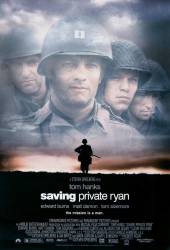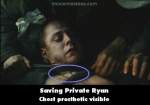Factual error: The American troops at Ramelle bridge are supposed to be fighting the 2nd SS Panzer Division. Two things wrong: the 2nd SS never had Tiger tanks in Normandy, having turned over their Tiger battalion to another unit in Russia prior to being transferred to France. Second, in the scenes with the Tigers, a 1st SS Panzerkorps insignia (Crossed Keys) is seen on the front right hull of the Tigers; 2nd SS Panzer Division was never a part of 1st SS Panzerkorps.
Factual error: When Jackson takes out the German sniper, we see the German snipers point of view through his scope and he eventually spots Jackson who fires at him. First you see the flash, then the bang, and then the German sniper gets hit through his scope. This is wrong because bullets from a powerful sniper rifle travel much faster than sound, he couldn't have heard the shot before he got hit. (00:51:30)
Suggested correction: He wasn't using a high powered sniper rifle. It was just a Springfield 1903 bolt action rifle which was the basic rifle of the US military until the M1 Garand. Snipers in WW2 didn't always have a scope either.
The Springfield still fired a supersonic round - all rifles do unless the round has been extensively modified, and no sniper would use such rounds.
The 30-06 is a powerful cartridge and the Springfield a very competent rifle. Snipers had scopes. The mistakes in that scene are that tower doesn't remotely look 400 yards away. Had it been then the projectile at 400 would have hit the German at a steep angle and could not have gone through the scope.
Continuity mistake: In the final battle Captain Miller is shouting at Mike, who's slumped against the sandbags, dead. The wound on his left shoulder has disappeared.
Suggested correction: Mike was shot in his right shoulder, not his left.
Stupidity: When they are preparing for a German assault towards the end of the movie, Miller explains to them the concept of the sticky bomb and adds, "If you have a better idea of knocking the treads off a tank I'd like to hear it." Um... The bazooka? They had eight rounds for it, and it could have easily been used to disable the treads. And the men wouldn't blow themselves up with it. While it couldn't destroy a tank by penetrating the armour, it's certainly strong enough to disable the tracks.
Suggested correction: Allied forces familiar with the Panzer VI "Tiger", a 60-ton Main Battle Tank during the war knew that the armor is very tough and, even with support fire from a friendly tank, the odds of destroying a Tiger tank with a bazooka like Horvath's are pretty small. From the infantry perspective, techniques that were developed and employed in order to combat heavy Tiger tanks focused mainly on disabling the tank rather than destroying it. Anti-tank weapons of the era, such as the bazooka, were ineffective against most areas of the Tiger's armor, so specific weak points in the design were the focus. Hitting the Tiger in the tracks, suspension, engine compartment, observation slits, and in the joint between the main body and turret were some of the common weak points. Tiger tanks could only be destroyed head-on or from the sides by land mines, or direct hits by heavy artillery shells, or bombs dropped from aircraft. In the film, the first Tiger is disabled by taking out the tracks with "sticky bombs" followed by grenades thrown in the turret hatch. When Horvath fires at the second Tiger, both shots are placed on the joint between the body and the turret, the idea most likely being to hinder or incapacitate the turret's ability to swivel left or right. As the war went on, the Allies developed better strategies for disabling Tigers. One example involved British Cromwell or US Sherman tanks trying to "flank" a Tiger by working in squadrons or columns. One or more tanks would act as a diversion to keep the Tiger's crew focused in front of it while another tank would maneuver behind the Tiger and hit it in the rear section where its armor was the weakest.
Revealing mistake: The shot of the eight members of the group is reused later in the film when there should only be seven.
Suggested correction: This is much too vague. Where is the repeated shot used?
Factual error: Near the end of the movie when an American fighter saves the day, it's a P-51 Mustang. In June, 1944 the most likely ground support fighter would have been the P-47 Thunderbolt. Also, American planes were still painted olive drab at that point. The Mustang in the movie did have black and white invasion stripes, but it's the wrong plane and the wrong color.
Suggested correction: The P-51 was one of the most commonly used fighter planes in the USAF by mid-1944. These planes had been flying in Europe since 1942, starting with the RAF, its original user. There are colored pictures of Mustangs with the paint job depicted in the movie from mid-1944 as well.
Other mistake: Private Mellish and another fellow Airborne soldier are manning the .30 cal belt fed machine-gun, and they're quickly running out of ammunition. Private Upham is the ammo bearer, he's supposed to be "Johnny on the spot" with the ammo. After Mellish displaces and sets up a new field of fire he tells Upham to get more .30 cal and to tell the Captain the flank's going to collapse. As Upham is dodging German gunfire he runs by a wall covered with fresh red blood spray. Nobody from that crew was shot yet. (02:15:29 - 02:17:00)
Suggested correction: It is not blood spray; it is red wine. There are two bottles in the cabinet beside Upham. Just before he leaves to get more ammo, a few shots come into the room, hitting the cabinet and the bottles, spraying red wine onto the wall.
Continuity mistake: Right before Capazzo dies he holds up the letter, but it's in a zip-lock bag. After the sniper is killed the medic retrieves the soaking wet, unbagged letter.
Suggested correction: The letter is never in any bag, plastic or otherwise. It's always bare or else he wouldn't be worried if there is blood on it. Zip-lock bags weren't invented until the 1950's anyway.
Revealing mistake: When Steamboat Willie shoots a paratrooper running across the bridge who falls off and into the water in the middle right of the bridge you can see a crewmember's right arm in the shot.
Suggested correction: This is not a crew member. This is Captain Miller's arm as he is just getting to his feet to walk towards the detonator.
Other mistake: When Ryan and Miller are using the mortars without the tube, there is one shot of a German soldier being hit and falling forward. A couple of seconds later this same shot is used again. (02:21:30)
Suggested correction: They are different shots. When the first soldier is blown up, there is only one soldier visible behind him. When the second soldier is blown up, you can see multiple soldiers behind him. Also, the second soldier has a limb blown off, which can be seen in the explosion, whereas the first did not.







Suggested correction: Nowhere is it said that they were exclusively fighting the 2nd SS Panzer division...the only hint of the 2nd SS is the recon probe (half-track scene.) Different units are more than capable of linking up and fighting together (2nd rangers and 101st for example) it is also stated that there are only 2 bridges intact along the Merderet river and that the Germans need to get their armor across anywhere they can. It's entirely plausible that multiple armor units converged and fought together.
Steve Kozak
The map Capt. Miller pulls out during the scene where they are questioning the columns of soldiers by the glider wreckage shows "2nd SS Panzer" written on his map at the location where they need to go, the city of Ramelle.
Scott215
That is 100% correct Scott, but where does it say that it is exclusively the 2nd SS Panzer division? Multiple units can link up together, especially when there are only 2 intact bridges to cross a river that needs to be crossed...other units are more than capable of converging together to do just that.
Steve Kozak